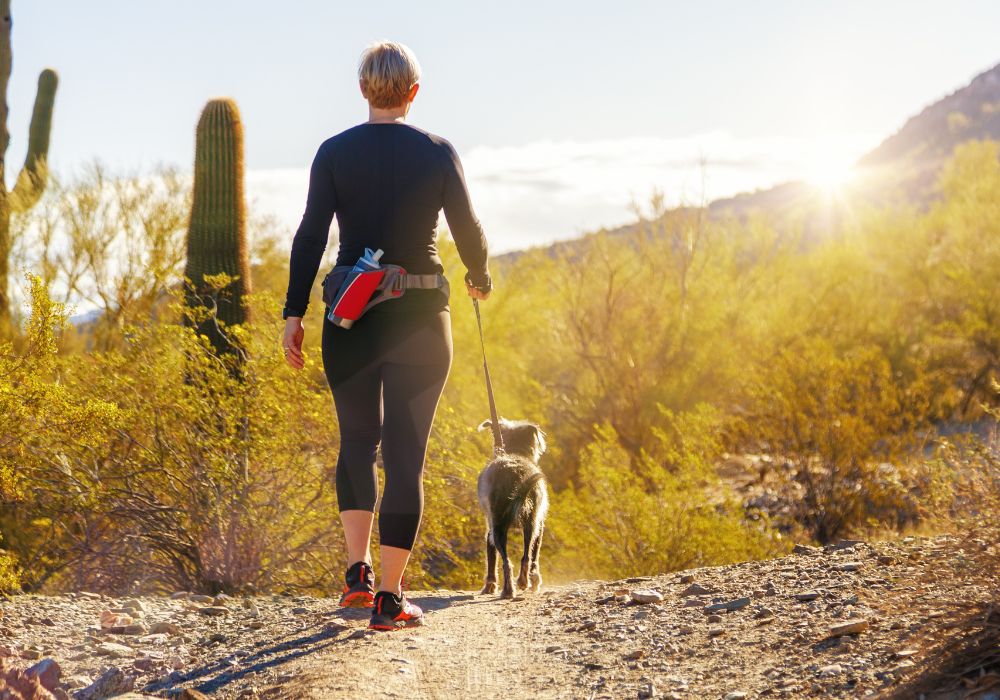Senior-Safe Desert Hiking: Enjoying Arizona Nature at Any Age
Key Takeaways
Proper preparation, including hydration, sun protection, and appropriate gear, is essential for seniors hiking in Arizona's desert climate
Choosing senior-friendly trails with moderate difficulty levels and accessibility features can make desert hiking enjoyable and safe for older adults
Hiking with companions and maintaining communication devices enhances safety for seniors exploring Arizona's natural landscapes
Regular desert hiking offers significant physical and mental health benefits for seniors, including improved cardiovascular health and reduced stress
Comfort Keepers Phoenix can provide companion support, transportation to trails, and assistance with preparing for outdoor activities
Is Desert Hiking Safe for Seniors in Arizona?
Absolutely! Desert hiking can be both safe and immensely rewarding for seniors when approached with proper preparation and awareness of limitations. Arizona's diverse desert landscapes offer numerous trails specifically suitable for older adults, with many providing accessibility features, moderate terrain, and breathtaking views that can be enjoyed at a comfortable pace.
Understanding Arizona's Desert Environment for Senior Hikers
Arizona's desert landscape presents a unique and breathtaking environment for hikers of all ages, but it requires special consideration for seniors seeking to enjoy its natural beauty. The state features several distinct desert ecosystems, including the iconic Sonoran Desert, known for its majestic saguaro cacti and diverse wildlife. While these landscapes offer incredible hiking opportunities, understanding the specific characteristics of desert environments is crucial for senior safety and enjoyment.
The desert climate in Arizona varies significantly throughout the year, with extreme temperature fluctuations that demand careful planning. Summer temperatures regularly exceed 100°F, making early morning or evening hikes essential during warmer months. Conversely, winter mornings can be surprisingly chilly, though they typically warm to comfortable temperatures by midday. This seasonal variation allows for year-round hiking possibilities when properly timed.
What makes Arizona's desert uniquely challenging is its combination of intense sun exposure, low humidity, and minimal shade. These factors create a high risk of dehydration and heat-related illnesses that can affect seniors more severely than younger hikers. According to the CDC, older adults are more susceptible to heat stress because their bodies don't adjust as well to sudden temperature changes, and they're more likely to have chronic medical conditions that affect normal body responses to heat.
The terrain itself presents both opportunities and challenges. While many imagine deserts as endless sand dunes, Arizona's landscapes feature diverse topography including rocky outcroppings, gentle slopes, canyon systems, and relatively flat desert floors. This variety means seniors can select trails that match their physical capabilities while still experiencing the desert's natural splendor.
Arizona's desert ecosystem also hosts unique flora and fauna that enhance the hiking experience. From the iconic saguaro cacti that can live for 150-200 years to the vibrant wildflower blooms following seasonal rains, the plant life offers ever-changing scenery throughout the year. Wildlife encounters might include roadrunners, jackrabbits, lizards, and occasionally, from a safe distance, javelinas or coyotes.
Understanding the desert's natural rhythm is vital for senior hikers. Desert environments typically experience two rainy seasons – winter rains from December through March and summer monsoons from July through September. These patterns affect trail conditions, wildlife activity, and even the risk of flash flooding in certain areas. The National Weather Service reports that flash floods are among the leading causes of weather-related deaths in Arizona, making weather awareness crucial for hikers.
For seniors, the desert's natural beauty offers profound psychological benefits alongside physical activity. Research from the National Institute on Aging suggests that spending time in natural environments can reduce stress, improve mood, and enhance cognitive function – all particularly valuable for older adults. Many seniors report that the desert's expansive vistas and unique ecosystem provide a sense of perspective and connection to something greater than themselves.
Essential Considerations for Senior Desert Hikers
Physical Preparation and Health Considerations: Before embarking on desert hikes, seniors should assess their physical readiness and consult healthcare providers. According to the American Heart Association, regular physical activity like hiking can help manage conditions common among seniors, including hypertension and diabetes. However, existing health conditions may require specific precautions. For instance, those with heart conditions should avoid strenuous hikes during extreme temperatures, while individuals with mobility issues might need hiking poles for stability. It's advisable to start with shorter, less challenging trails and gradually build endurance.
Climate and Weather Awareness: Arizona's desert climate demands careful attention to weather forecasts and seasonal considerations. The CDC reports that heat-related illnesses affect older adults disproportionately, making timing crucial. Winter months (November through March) offer ideal hiking conditions with daytime temperatures typically between 60-75°F. During summer, hiking should be limited to early morning hours (before 9 AM) when temperatures are more moderate. Always check weather forecasts for excessive heat warnings or monsoon activity, which can create dangerous conditions including flash floods in canyon areas.
Hydration and Nutrition Requirements: Proper hydration is non-negotiable for desert hiking. The American College of Sports Medicine recommends that older adults drink water before feeling thirsty, as the sensation of thirst diminishes with age. For desert hiking, seniors should consume approximately 1 liter of water for every 2 hours of activity, with additional electrolyte supplements during longer hikes. Nutritionally, small, energy-dense snacks like nuts, dried fruits, and granola bars help maintain energy levels. Avoid alcohol and excessive caffeine, which can contribute to dehydration.
Trail Selection and Accessibility: Arizona offers numerous trails specifically suitable for seniors. The accessibility of trails varies significantly, with some providing paved paths, gentle grades, and rest areas that accommodate mobility limitations. Resources like the Arizona State Parks website categorize trails by difficulty level, helping seniors select appropriate routes. Popular senior-friendly options include the Desert Botanical Garden trails in Phoenix, the Rim Trail at the Grand Canyon's South Rim, and the Wild Burro Trail in Tucson's Tortolita Mountains. These trails combine natural beauty with manageable terrain.
Senior-Friendly Desert Trails in Arizona
Urban Desert Parks: Phoenix and surrounding communities offer accessible desert experiences within city limits. The Desert Botanical Garden features paved, wheelchair-accessible trails showcasing desert plant collections. South Mountain Park provides numerous gentle trails with stunning city views, including the ADA-accessible Judith Tunell Accessible Trail. These urban parks combine natural desert environments with amenities like restrooms, water stations, and emergency services nearby – ideal for seniors new to desert hiking.
State Park Trails: Arizona's state parks feature well-maintained trails with clear signage and regular ranger patrols. Lost Dutchman State Park near Apache Junction offers the Native Plant Trail, a 0.25-mile accessible loop perfect for beginners. Catalina State Park near Tucson features the Birding Trail, a 1-mile flat path with benches and bird-watching opportunities. These state park trails typically provide parking near trailheads, reducing approach distances for seniors with limited mobility.
National Monument and Park Options: For more immersive experiences, Arizona's national monuments and parks offer senior-friendly trails with interpretive signage. Saguaro National Park's Valley View Overlook Trail (0.8 miles round-trip) provides spectacular views with minimal elevation change. At Montezuma Castle National Monument, the paved 0.3-mile loop offers archaeological interest without physical challenges. The National Park Service offers Senior Passes for U.S. citizens aged 62+, providing lifetime access to federal recreation sites for a one-time fee.
Seasonal Specialty Trails: Certain trails shine during specific seasons. The Superstition Wilderness's First Water Trail offers spectacular wildflower viewing in spring, while Boyce Thompson Arboretum's Main Trail provides shade and cooler temperatures during summer months. Seniors should research seasonal highlights to enhance their hiking experiences throughout the year.
Essential Safety Strategies for Senior Desert Hikers
Proper Hydration and Sun Protection: The cornerstone of desert hiking safety is proper hydration. Seniors should begin hydrating the day before a planned hike and continue drinking water regularly throughout the activity. The Mayo Clinic recommends carrying at least one gallon of water per person for a day hike in desert conditions. A practical approach is using a hydration backpack with a drinking tube for convenient sipping while walking. Electrolyte replacement drinks or tablets are valuable supplements, especially on longer hikes, as they replace crucial minerals lost through perspiration.
Sun protection requires a comprehensive approach. Apply broad-spectrum sunscreen (SPF 50+) 30 minutes before starting and reapply every two hours. Cover exposed skin with lightweight, light-colored, long-sleeved clothing made from UPF-rated fabrics. Wide-brimmed hats provide better protection than baseball caps by shading the neck and ears. Quality sunglasses with UV protection prevent eye damage and reduce glare. Some seniors find cooling neck wraps or bandanas soaked in water particularly helpful for temperature regulation.
Appropriate Gear and Equipment: Proper footwear is non-negotiable for desert hiking. Trail-specific hiking shoes or boots with ankle support and thick soles protect against rocky terrain and potential cactus spines. Moisture-wicking socks prevent blisters and keep feet comfortable. Many seniors benefit from trekking poles, which provide stability on uneven terrain and reduce impact on knees and joints during descents.
A well-packed daypack should include: a detailed trail map (even with smartphone GPS), a basic first aid kit with blister treatment supplies, a multi-tool or knife, a whistle for emergencies, a headlamp or flashlight with extra batteries, and a lightweight emergency blanket. For seniors with medical conditions, always carry necessary medications and medical information. A hiking seat or collapsible stool allows for comfortable rest breaks. Consider bringing a cell phone signal booster in remote areas where reception may be limited.
Hiking with Companions and Communication Plans: The buddy system significantly enhances safety for senior hikers. Ideal hiking companions understand the pace and abilities of the group and can provide assistance if needed. Many communities have senior hiking clubs that organize regular outings with age-appropriate trails and pacing. These groups offer social benefits alongside safety advantages.
Before departing, always share your detailed hiking plan with a non-hiking contact, including the specific trail, expected return time, and check-in procedures. Modern technology offers excellent safety enhancements: GPS tracking devices with emergency buttons can summon help even in areas without cell service. Several hiking apps allow real-time location sharing with family members. Some seniors wear medical alert devices specifically designed for outdoor activities.
Recognition and Response to Health Emergencies: Seniors should be familiar with the early warning signs of heat-related illnesses, which can progress rapidly in desert environments. Initial symptoms include excessive sweating, fatigue, thirst, and muscle cramps. If these occur, immediately seek shade, rest, hydrate, and cool the body. More serious symptoms like confusion, headache, nausea, and reduced sweating require immediate cessation of activity and cooling measures.
For seniors with chronic conditions like heart disease or diabetes, understanding how exertion and heat affect these conditions is crucial. Carry appropriate emergency medications and know when to use them. The American Heart Association recommends that hikers with heart conditions learn the difference between expected exertion discomfort and warning signs requiring immediate attention. Practice emergency response scenarios before they're needed, including how to communicate your location to emergency services.
Enhancing the Desert Hiking Experience for Seniors
Guided Interpretive Hikes: Many Arizona parks and conservation organizations offer senior-specific guided hikes led by naturalists or park rangers. These experiences provide educational content about desert ecology, geology, and history while ensuring appropriate pacing and rest breaks. Organizations like the Desert Botanical Garden in Phoenix offer "Senior Strolls" specifically designed for older adults, combining gentle exercise with learning opportunities. These guided experiences allow seniors to focus on enjoyment rather than navigation or trail finding.
The interpretive aspect significantly enhances the hiking experience by helping seniors understand what they're seeing. Learning to identify common desert plants, recognize animal tracks, or understand geological formations adds depth to the experience. Many seniors report that this educational component provides mental stimulation alongside physical activity. Additionally, guided hikes typically follow well-vetted routes known to be appropriate for older participants.
Photography and Nature Observation: Desert environments offer extraordinary photography opportunities that encourage seniors to pause, observe, and appreciate their surroundings. The changing light throughout the day creates dramatic effects on desert landscapes, with early morning and late afternoon offering the most striking conditions. Many seniors find that photography provides both a creative outlet and a natural reason to take breaks during hikes.
Birding is particularly popular among senior desert hikers, with Arizona hosting over 550 bird species. Lightweight binoculars and a pocket bird guide can transform a simple hike into a fascinating wildlife observation experience. Seasonal wildflower blooms, especially following winter rains, provide spectacular viewing and photography opportunities. These nature observation activities naturally slow the hiking pace, making them well-suited for seniors who prefer a more contemplative outdoor experience.
Cultural and Historical Connections: Arizona's deserts contain rich cultural histories spanning thousands of years. Many trails pass by or lead to archaeological sites, historical mining operations, or areas significant to indigenous cultures. Seniors often find these historical connections particularly meaningful, providing context that enhances their appreciation of the landscape.
The Pueblo Grande Museum and Archaeological Park in Phoenix features trails passing through an ancient Hohokam village site with interpretive signage. The Superstition Mountains trails connect to legends of the Lost Dutchman's Gold Mine. Learning about these cultural and historical aspects before hiking adds significant dimension to the experience. Many seniors report that understanding the human history of these landscapes creates a deeper connection to the environment.
Seasonal Adaptations: Arizona's desert offers year-round hiking possibilities with seasonal adaptations. Winter and spring (November through April) provide ideal conditions for longer, more exposed trails, while summer requires early morning starts on shaded routes. Fall brings comfortable temperatures and fewer crowds. Many experienced senior hikers maintain a seasonal trail rotation, visiting higher elevations during summer months and lower desert trails during winter.
Adapting expectations to seasonal conditions ensures year-round enjoyment. During monsoon season (typically July through September), selecting trails away from washes and canyons reduces flash flood risks. Spring wildflower seasons may warrant visiting specific trails known for spectacular blooms. These seasonal adaptations allow seniors to maintain their hiking practice throughout the year while experiencing the desert's changing character.
How Comfort Keepers Phoenix Can Help
At Comfort Keepers Phoenix, we understand that maintaining an active lifestyle is crucial for seniors' physical and mental well-being. Our Interactive Caregiving™ approach aligns perfectly with supporting seniors who wish to enjoy Arizona's beautiful desert landscapes through hiking and outdoor activities.
Our companion caregivers can provide valuable assistance for seniors interested in desert hiking in several ways. First, we offer reliable transportation to and from trailheads, eliminating the stress of driving and parking at sometimes crowded recreation areas. Our caregivers are familiar with many senior-friendly trails throughout the Phoenix area and can help clients select appropriate routes based on their abilities and preferences.
Preparation for desert hiking requires attention to detail that can sometimes be overwhelming. Our caregivers can assist with gathering necessary supplies, preparing appropriate snacks and meals, filling water containers, and ensuring all safety equipment is packed. For seniors who might forget important items like sunscreen, medications, or sun protection, having a companion provides an extra layer of security and preparation.
During the hike itself, our caregivers can provide physical support when needed, such as offering a steady arm on uneven terrain or carrying supplies. They're trained to recognize signs of fatigue, dehydration, or heat stress – crucial skills in Arizona's desert environment. Having a companion who understands these risks can make the difference between a pleasant outing and a dangerous situation.
For seniors with chronic conditions like diabetes, heart disease, or mobility issues, our caregivers receive specialized training to understand how these conditions might affect outdoor activities. They can monitor for warning signs, ensure medication schedules are maintained, and provide appropriate assistance if needed. This specialized knowledge allows seniors with health challenges to still enjoy nature safely.
The social aspect of hiking with a Comfort Keepers companion enhances the experience significantly. Shared observations, conversations about nature, and the security of having someone to talk with make desert hikes more enjoyable. Our caregivers are selected for their engaging personalities and genuine interest in seniors' well-being, making them excellent hiking companions.
Beyond the hike itself, our services extend to post-activity support. This might include assistance with showering or changing clothes after returning home, preparing a nutritious recovery meal, or helping with any muscle soreness through gentle stretching or applying topical pain relievers if approved by healthcare providers.
For seniors who are just beginning to explore desert hiking, we can help establish a gradual conditioning program. Our caregivers can accompany clients on progressively longer walks in their neighborhoods before attempting actual trails, helping build the stamina and confidence needed for desert hiking.
At Comfort Keepers Phoenix, we believe that age should not limit seniors' ability to connect with Arizona's natural beauty. Our personalized care plans can incorporate outdoor activities like desert hiking as part of our commitment to fostering physical activity, mental stimulation, and social engagement. By providing the right support, we help seniors continue enjoying the remarkable desert landscapes that make Arizona special – safely, confidently, and with companionship that enhances the experience.
If you or your loved one wishes to explore Arizona's desert trails but needs additional support, contact Comfort Keepers Phoenix to learn how we can help create a care plan that includes these enriching outdoor activities. Our team is ready to help seniors enjoy nature at any age, with the safety, preparation, and companionship that makes desert hiking a rewarding experience.










